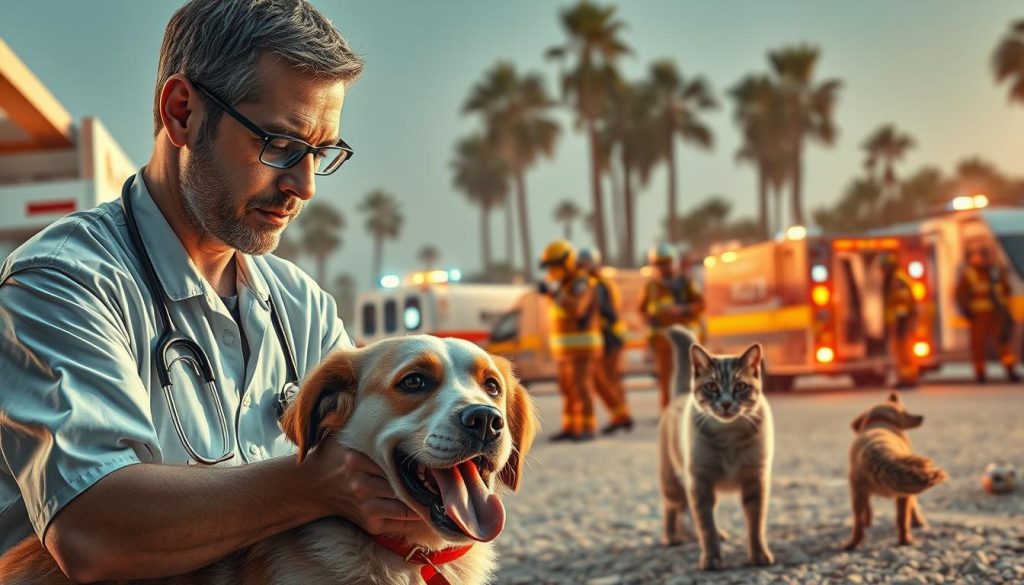As temperatures soar to unprecedented levels, pet owners must be aware of the risks associated with extreme heat and take necessary precautions to ensure their pets’ safety. With the growing demand for pet care services, especially during emergencies, it’s crucial to adapt our pet care routines accordingly.
The increasing frequency of record heat waves is reshaping the way we care for our pets. As VEG, a leading pet care service with over 100 locations nationwide, notes, their hospitals are open 24/7, providing flexibility in shift hours and underscoring the growing need for emergency pet care.
Key Takeaways
- Recognizing signs of heat distress in pets
- Innovative cooling technologies for pet care
- Adapting pet care routines for extreme heat
- Importance of 24/7 pet care services
- Preparing for pet emergencies during summer
The2025 Summer Pet Emergency: How Record Heat is Reshaping Pet Care
The summer of 2025 is shaping up to be one of the hottest on record, posing significant risks to our furry friends. As temperatures soar, pet owners must be aware of the potential dangers and take proactive steps to protect their pets.
Unprecedented Temperature Records Across the United States
The United States is bracing for record heatwaves this summer. According to recent climate data, many regions are expected to experience temperatures above historical averages.
This extreme weather poses a significant threat to pets, who can quickly succumb to heat-related illnesses. It’s essential for pet owners to stay informed about local weather forecasts and plan accordingly.
| Region | Average Summer Temperature | Record Temperature |
|---|---|---|
| Northeast | 85°F | 100°F |
| Southwest | 105°F | 120°F |
| Southeast | 90°F | 105°F |
The New Normal for Pet Owners
As we adapt to the new normal of extreme temperatures, pet owners must adjust their pet care routines. This includes providing extra hydration, creating cool zones in the home, and adjusting exercise schedules.
Key adaptations include:
- Providing cool, shaded areas for pets to relax
- Ensuring access to plenty of fresh water
- Avoiding exercise during the hottest parts of the day
By taking these precautions, pet owners can help mitigate the risks associated with record heat and keep their pets safe this summer.
Understanding Heat-Related Risks for Different Pet Species
The impact of extreme heat on pets varies significantly across species, necessitating a closer look at how to mitigate these risks. As temperatures soar, it’s crucial for pet owners to understand the specific heat-related challenges their pets might face.
Dogs and Heat Vulnerability
Dogs are particularly vulnerable to heat stress due to their fur coats and varying ability to cool themselves. Certain breeds are at higher risk.
High-Risk Breeds and Characteristics
Breeds with brachycephalic (flat) faces, such as Pugs and Bulldogs, are more susceptible to heatstroke due to their compromised ability to breathe. Similarly, dogs with thick coats or those that are overweight may also struggle with heat.
Age-Related Considerations
Puppies and older dogs are at increased risk due to their less efficient temperature regulation mechanisms. It’s essential to monitor these dogs closely during hot weather.
Cats and Heat Tolerance
Cats, while generally more adept at avoiding heat than dogs, still face significant risks during extreme heat waves.
Indoor vs. Outdoor Cats
Indoor cats are somewhat protected from direct heat but can still suffer from heatstroke if their living spaces are not adequately cooled. Outdoor cats face direct sunlight and higher temperatures, increasing their risk.
Breed-Specific Concerns
Certain cat breeds, like Persians, with their long fur, may require extra grooming during hot months to prevent overheating.
Small Pets and Exotic Animals
Small pets, including rodents and rabbits, and exotic animals like reptiles and birds, have unique needs during heatwaves.
Rodents and Rabbits
These small mammals can suffer from heat stress, especially if their cages are exposed to direct sunlight or are in poorly ventilated areas.
Reptiles and Birds
Reptiles, being cold-blooded, regulate their body temperature using external sources, which can be a challenge during extreme heat. Birds may also face heat stress, particularly if their cages are in direct sunlight or not well-ventilated.
Recognizing Signs of Heat Distress in Pets
Heat distress in pets can be life-threatening, making it essential to identify the warning signs early. Pet owners must be vigilant about their pets’ health, especially during the hot summer months when temperatures can soar to record highs.
Early Warning Symptoms
Some early signs of heat distress in pets include excessive panting, drooling, and restlessness. Pets may also exhibit lethargy or a lack of interest in their usual activities. It’s crucial to monitor these symptoms closely, as they can quickly escalate into more severe conditions.
- Panting heavily
- Drooling more than usual
- Showing signs of restlessness or agitation
Critical Emergency Indicators
If your pet is experiencing severe difficulty breathing, collapse, or seizures, it’s a critical emergency that requires immediate veterinary attention. These symptoms indicate that your pet is suffering from severe heatstroke, which can be fatal if not treated promptly.
- Severe difficulty breathing or rapid breathing
- Collapse or fainting
- Seizures or convulsions
Behavioral Changes That Signal Heat Stress
Changes in behavior can also signal heat stress in pets. If your pet becomes unusually agitated, withdrawn, or shows a lack of responsiveness, it may be experiencing heat distress. Keeping a close eye on your pet’s behavior and watching for any deviations from their normal behavior is crucial.
As the data suggests, being proactive and seeking veterinary care if you suspect your pet is experiencing heat distress is vital. If you have any questions about our hospital or procedures, don’t hesitate to ask! Early recognition and response to heat distress can significantly improve your pet’s chances of recovery.
Emergency Response Protocols for Overheated Pets
As temperatures soar, pet owners must be equipped with the knowledge to handle heat-related emergencies. Overheated pets can quickly become life-threatening situations if not addressed promptly and properly.

Immediate First Aid Measures
When a pet shows signs of heat distress, immediate action is crucial. The goal is to lower the pet’s body temperature safely and efficiently.
Safe Cooling Techniques
Cooling methods should focus on gradual temperature reduction. Techniques include:
- Moving the pet to a cooler area, such as an air-conditioned room.
- Applying cool water to the pet’s body, particularly around the neck and armpits.
- Using fans to circulate air and enhance cooling.
What Not To Do
It’s equally important to know what actions to avoid when dealing with an overheated pet:
- Avoid using ice or very cold water, as this can cause shock.
- Do not restrain the pet too tightly, as this can impede breathing.
- Never leave a pet in a hot car, even with windows slightly ajar.
When to Contact Emergency Veterinary Services
If your pet shows severe signs of heat distress, such as difficulty breathing, seizures, or collapse, contact an emergency veterinary service immediately. Facilities like VEG, with hospitals open 24/7, can provide critical care.
Transportation Safety During Heat Emergencies
When transporting an overheated pet to a veterinary clinic, ensure the vehicle is cool and well-ventilated. Use a carrier or restraint to keep the pet safe, and continue to provide cooling measures during transport.
Transforming Daily Pet Care Routines for Extreme Heat
As the temperature soars, it’s crucial to rethink our daily pet care routines to keep our furry friends safe. The extreme heat we’re experiencing requires a multifaceted approach to ensure our pets remain comfortable and healthy.
Adjusted Exercise Schedules and Methods
Modifying exercise routines is vital during extreme heat. Early morning and late evening activities are preferable as they avoid the peak heat of the day.
Early Morning and Late Evening Activities
Engaging in physical activities with your pet during these cooler parts of the day can help prevent heat stress. For instance, a brisk walk or playtime in the morning or evening can be both enjoyable and safe for your pet.
Indoor Exercise Alternatives
On extremely hot days, consider indoor activities such as hide-and-seek, indoor fetch, or even simple obedience training. These activities keep your pet engaged and active without exposing them to the harsh outdoor conditions.
Hydration Strategies Beyond Water Bowls
Ensuring your pet stays hydrated is critical. Beyond just having fresh water available, you can incorporate hydrating treats and moisture-rich foods into their diet. This not only helps with hydration but also adds variety to their meals.
Creating Cool Zones in Your Home
Creating cool zones in your home can provide your pet with much-needed relief from the heat.
Low-Tech Cooling Solutions
Simple, low-tech solutions include using cooling pads or mats, and even a damp towel can provide a cooling effect for your pet to lie on.
Pet-Safe Air Conditioning Practices
If you have air conditioning, ensure it’s used safely for your pet. Keep the temperature at a comfortable level, and consider using pet-safe fans to circulate air. “We find a way to say yes to helping you give people and their pets the best care,” emphasizing the importance of adapting pet care routines to meet the challenges of extreme heat.
Innovative Pet Cooling Technologies of2025
The year 2025 is witnessing a significant leap in pet cooling technologies, offering new hope for pet owners worldwide. As extreme heat becomes a recurring issue, the demand for effective and innovative cooling solutions for pets is on the rise. This has led to the development of various cutting-edge products and services designed to keep pets safe and comfortable.
Advanced Cooling Wearables and Accessories
One of the most exciting developments in pet cooling technologies is the emergence of advanced cooling wearables and accessories. These include cooling vests, bandanas, and mats that are designed to keep pets cool. For instance, some cooling vests are made with special materials that stay cool even when not in contact with cold packs, providing continuous cooling relief.
Smart Home Climate Control for Pets
Smart home climate control systems are another innovative solution for pet owners. These systems allow for precise temperature control and can be programmed to maintain a comfortable environment for pets even when their owners are away. Some systems also come with pet-friendly features such as air purification and humidity control, enhancing the overall comfort and health of pets.
Emerging Veterinary Treatments for Heat-Related Conditions
Veterinary medicine is also evolving to address heat-related conditions in pets. New treatments and therapies are being developed to help pets recover from heat stress more effectively. These include advanced IV therapies and medications that can help mitigate the effects of extreme heat on pets’ health.
How Veterinary Practices Are Adapting to the Climate Crisis
The growing threat of extreme heat is forcing veterinary practices to rethink their emergency services. As temperatures soar, the demand for veterinary care increases, prompting clinics to adapt and expand their offerings.
Extended Emergency Hours and Services
Veterinary clinics are now offering extended emergency hours to cater to pets suffering from heat-related illnesses. For instance, VEG, with over 100 locations nationwide, has seen a significant surge in emergency visits during heatwaves, highlighting the need for around-the-clock care. Extended hours ensure that pets receive timely medical attention, reducing the risk of heatstroke and other heat-related conditions.
Specialized Heat Treatment Facilities
Some veterinary practices are investing in specialized heat treatment facilities equipped with state-of-the-art cooling technology. These facilities provide a controlled environment for treating pets with severe heat stress. Advanced cooling systems and monitoring equipment help veterinarians to provide more effective treatment.
Preventative Care Recommendations
Veterinary practices are also focusing on preventative care to mitigate the effects of extreme heat. They are educating pet owners on the importance of hydration, providing tips on creating cool zones in homes, and recommending adjusted exercise schedules.
- Providing cool, shaded areas for pets
- Limiting exercise to cooler parts of the day
- Ensuring access to plenty of fresh water
are some of the strategies being promoted.
| Preventative Measure | Benefit |
|---|---|
| Creating cool zones in homes | Reduces heat exposure |
| Adjusted exercise schedules | Minimizes heat stress risk |
| Hydration strategies | Prevents dehydration |
Regional Pet Care Adaptations Across America
As temperatures soar, regional pet care adaptations become crucial across America. The diverse climate conditions across the country necessitate tailored approaches to keeping pets safe and healthy during extreme heat.
Southern Heat Management
States like Arizona and Texas have long been accustomed to sweltering summers. Pet owners in these regions have established heat management practices, including keeping pets indoors during the hottest parts of the day and providing ample shade and hydration. For instance, many pet owners use cooling pads and misting systems to keep their pets cool.
Northern Regions Facing New Challenges
Northern states, such as Minnesota and New York, are experiencing hotter summers than in the past. Pet owners in these areas are adapting to the new normal by implementing cooling measures they previously didn’t need, like using air conditioning and cooling vests for pets.
Coastal vs. Inland Pet Care Differences
The difference between coastal and inland regions also plays a significant role in pet care. Coastal areas tend to have milder temperatures compared to inland regions. For example, pet owners in San Francisco might not need to take the same precautions as those in Sacramento. Understanding these regional nuances is key to effective pet care during heatwaves.
By recognizing and adapting to these regional differences, pet owners across America can better protect their pets from the dangers of extreme heat.
Conclusion: Preparing for Future Summers with Our Pets
As we navigate the challenges of extreme heat, it’s clear that preparing for future summers with our pets requires a proactive approach to pet care. By understanding the risks associated with rising temperatures, we can take steps to mitigate them and keep our pets safe.
Adapting our daily pet care routines is crucial in the face of extreme heat. This includes adjusting exercise schedules, providing innovative hydration strategies, and creating cool zones in our homes. Leveraging cutting-edge pet cooling technologies can also make a significant difference in our pets’ comfort and health.
As the climate continues to evolve, staying informed and prepared is key. By embracing the unexpected challenges that come with extreme heat and being prepared to adapt, we can ensure our pets remain healthy and happy. As emphasized, “We’re not here to do the usual; we’re here to do the unexpected,” highlighting the importance of being prepared for the unexpected in pet care during extreme heat.






